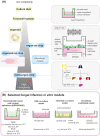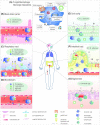In vitro infection models to study fungal-host interactions
- PMID: 33524102
- PMCID: PMC8498566
- DOI: 10.1093/femsre/fuab005
In vitro infection models to study fungal-host interactions
Abstract
Fungal infections (mycoses) affect over a billion people per year. Approximately, two million of these infections are life-threatening, especially for patients with a compromised immune system. Fungi of the genera Aspergillus, Candida, Histoplasma and Cryptococcus are opportunistic pathogens that contribute to a substantial number of mycoses. To optimize the diagnosis and treatment of mycoses, we need to understand the complex fungal-host interplay during pathogenesis, the fungal attributes causing virulence and how the host resists infection via immunological defenses. In vitro models can be used to mimic fungal infections of various tissues and organs and the corresponding immune responses at near-physiological conditions. Furthermore, models can include fungal interactions with the host-microbiota to mimic the in vivo situation on skin and mucosal surfaces. This article reviews currently used in vitro models of fungal infections ranging from cell monolayers to microfluidic 3D organ-on-chip (OOC) platforms. We also discuss how OOC models can expand the toolbox for investigating interactions of fungi and their human hosts in the future.
Keywords: Aspergillus; Candida; Cryptococcus; Histoplasma; in vitro model; fungal–host interaction.
© The Author(s) 2021. Published by Oxford University Press on behalf of FEMS.
Figures


References
-
- Abbott NJ, Ronnback L, Hansson E. Astrocyte-endothelial interactions at the blood–brain barrier. Nat Rev Neurosci. 2006;7:41–53. - PubMed
-
- Ahadian S, Civitarese R, Bannerman Det al. . Organ-on-a-chip platforms: a convergence of advanced materials, cells, and microscale technologies. Adv Healthc Mater. 2018;7. - PubMed
-
- Aimanianda V, Bayry J, Bozza Set al. . Surface hydrophobin prevents immune recognition of airborne fungal spores. Nature. 2009;460:1117–21. - PubMed
-
- Akram SM, Koirala J. Histoplasmosis. Treasure Island, FL: StatPearls Publishing, 2020. - PubMed
Publication types
MeSH terms
Grants and funding
LinkOut - more resources
Full Text Sources
Other Literature Sources
Medical

